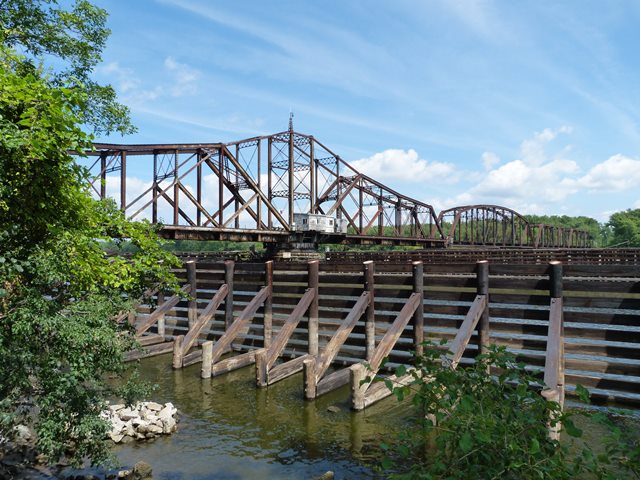We Recommend:
Bach Steel - Experts at historic truss bridge restoration.
BridgeHunter.com Phase 1 is released to the public! - Visit Now
La Crosse Railroad Bridge

Primary Photographer(s): Nathan Holth
Bridge Documented: August 9, 2013
Railroad (Canadian Pacific) Over Mississippi River (West Channel)
La Crescent: Houston County, Minnesota: United States
Metal Pin-Connected Pratt Through Truss, Movable: Swing (Rim Bearing Center Pier) and Approach Spans: Metal 9 Panel Pin-Connected Parker Through Truss, Fixed
1902 By Builder/Contractor: Phoenix Bridge Company of Phoenixville, Pennsylvania and Engineer/Design: Charles Frederick Loweth
1952
359.0 Feet (109.4 Meters)
1,055.2 Feet (321.6 Meters)
Not Available
1 Main Span(s) and 5 Approach Span(s)
Not Applicable

View Information About HSR Ratings
Bridge Documentation
This bridge is an increasingly rare surviving and unaltered example of a historic railroad bridge over the Mississippi River. Nearly all the historic railroad bridges on the Mississippi River are at a general risk for demolition or severe alteration. Numerous boats use the river, and the long-held dislike of boats for swing spans with obstructive center piers that has existed for well over a century remains alive today, putting the swing spans that are usually found on historic Mississippi River railroad bridges at risk for demolition. Furthermore, the limited number of railroad crossings over the river tends to funnel a lot of railroad mainline traffic onto the bridges, and so many are also at risk for severe alteration or replacement as railroads seek to run taller loads at higher speeds. The La Crosse Railroad Bridge has been targeted for demolition and replacement for the navigation reason in the past. For now, the plans appear to be halted, but the bridge should be considered to be at a general demolition risk as it is likely only a matter of time before the plans are reignited. As it stands, the La Crosse Railroad Bridge is significant for surviving in an unaltered condition. It has a variety of spans as follows from east to west: One 40.6 foot deck plate girder span, two 164.2 foot pin-connected Pratt through truss spans, one 248 foot pin-connected Parker truss span, one 359 foot pin-connected truss swing span, and one 75 foot deck plate girder span. Built in 1902 to replace an 1875 bridge, the 1902 bridge was originally steam powered but was converted to electrical in 1952. On average, 3400 bridge transits are made annually. A bridge tender is on duty 24 hours a day seven days a week.
View Historical Article About This Bridge
![]()
Photo Galleries and Videos: La Crosse Railroad Bridge
Bridge Photo-Documentation
Original / Full Size PhotosA collection of overview and detail photos. This gallery offers photos in the highest available resolution and file size in a touch-friendly popup viewer.
Alternatively, Browse Without Using Viewer
![]()
Bridge Photo-Documentation
Mobile Optimized PhotosA collection of overview and detail photos. This gallery features data-friendly, fast-loading photos in a touch-friendly popup viewer.
Alternatively, Browse Without Using Viewer
![]()
Bridge Being Opened
Full Motion VideoStreaming video of the bridge. Also includes a higher quality downloadable video for greater clarity or offline viewing.
![]()
Maps and Links: La Crosse Railroad Bridge
Coordinates (Latitude, Longitude):
Search For Additional Bridge Listings:
Bridgehunter.com: View listed bridges within 0.5 miles (0.8 kilometers) of this bridge.
Bridgehunter.com: View listed bridges within 10 miles (16 kilometers) of this bridge.
Additional Maps:
Google Streetview (If Available)
GeoHack (Additional Links and Coordinates)
Apple Maps (Via DuckDuckGo Search)
Apple Maps (Apple devices only)
Android: Open Location In Your Map or GPS App
Flickr Gallery (Find Nearby Photos)
Wikimedia Commons (Find Nearby Photos)
Directions Via Sygic For Android
Directions Via Sygic For iOS and Android Dolphin Browser
USGS National Map (United States Only)
Historical USGS Topo Maps (United States Only)
Historic Aerials (United States Only)
CalTopo Maps (United States Only)


